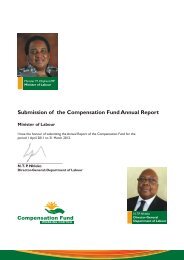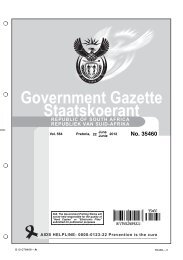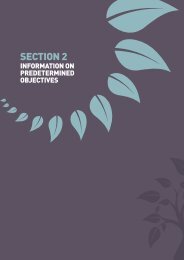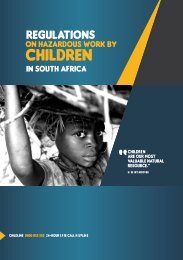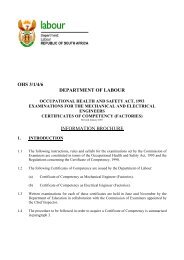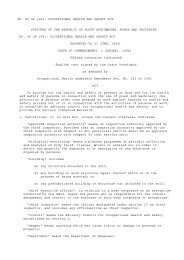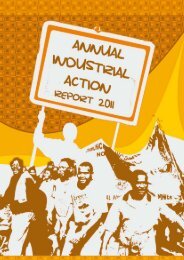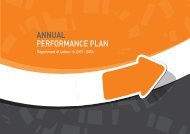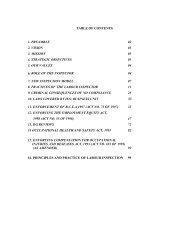PART B: STRATEGIC OBJECTIVES - Department of Labour
PART B: STRATEGIC OBJECTIVES - Department of Labour
PART B: STRATEGIC OBJECTIVES - Department of Labour
- No tags were found...
You also want an ePaper? Increase the reach of your titles
YUMPU automatically turns print PDFs into web optimized ePapers that Google loves.
Strategic Objectives Objective Statement Baseline Performance Indicator13. Effective andefficient supply chainmanagementEnsure implementation <strong>of</strong> supplychain management regulatoryframework100% compliance 13.1 Percentage <strong>of</strong> compliantinvoices paid within 30 days <strong>of</strong>receiptNew indicator13.2 Percentage reduction inirregular expenditure compared toprevious yearStrategic Plan 2013 - 201814. Effective andefficient management<strong>of</strong> facilities andtransportationProvision <strong>of</strong> facilities andtransportation managementAccommodation requestprocessed within sixmonths in advance toDPW14.1 Percentage <strong>of</strong>accommodation requests to DPWprocessed six months in advance4 monitoring reports 14.2 Number <strong>of</strong> monitoringreports on vehicle fleetmanagement7.1.4 Risk management: Risks within the Administration BranchRisk Description1. Introduction <strong>of</strong> in-house fleet vehiclemanagement servicePlanned Response Action1.1 Phasing-in <strong>of</strong> own vehicle fleet over 12 months had been affirmed in April2012 and the balance <strong>of</strong> Phakisa vehicles will be taken away by November20132. Poor contract management 2.1 Contract Review Panel (CRP) established3. Inadequate systems and processes for themanagement <strong>of</strong> performance information3.1 CD: PM&E in conjunction with the CIO, in the process <strong>of</strong> preliminarydiscussions with Micros<strong>of</strong>t for performance system4. Delays in security vetting and pre-screening 4.1 Implementation <strong>of</strong> Project Shanduka whereby establishment <strong>of</strong> a VettingUnit will be incorporated5. Over/under spending <strong>of</strong> the budget 5.1 The Budget Advisory Committee meets once a month to monitor theexpenditure <strong>of</strong> the <strong>Department</strong>.5.2 Meetings held with all Programme Heads for the purpose <strong>of</strong> discussingtheir spending patternspage 14
7.2 Programme 2: INSPECTION AND ENFORCEMENT SERVICES7.2.1. Programme purpose: To realise decent work by regulating non-employment and employment conditionsthrough inspection and enforcement in order to achieve compliance with all labour market policies7.2.2. Programme description: The programme consists <strong>of</strong> the following sub-programmes:• Management and Support Services: Inspection and Enforcement Services manages the delegated administrative and financialresponsibilities <strong>of</strong> the <strong>of</strong>fice <strong>of</strong> the Deputy Director-General: Inspection and Enforcement Services, and provides corporate supportto line function sub-programmes within the programme• Occupational Health and Safety promotes health and safety in the workplace by regulating dangerous activities and the use <strong>of</strong>plant and machinery• Registration: Inspection and Enforcement Services registers incidents relating to labour relations and occupational health andsafety matters, as reported by members <strong>of</strong> the public, and communicates these to the relevant structures within the Compliance,Monitoring and Enforcement sub-programme for investigation• Compliance, Monitoring and Enforcement ensures that employers and employees comply with labour legislation throughregular inspections and following-up on reported incidents• Training <strong>of</strong> staff: Inspection and Enforcement Services defrays all expenditure relating to staff training within this programme inorder to easily identify this expenditure for reporting purposes• Statutory and Advocacy gives effect to the legislative enforcement requirement and educate stakeholders on labour legislation.Strategic Plan 2013 - 2018Strategic outcome orientedgoals 1: (outcome 4)Improve the quality <strong>of</strong> labour market services to contribute to decent employment throughinclusive economic growthStrategic Goals 2: Promoting equity in the labour market (Outcome 4)3: Protecting vulnerable workers (Outcome 4)5: Strengthening social protection (Outcome 4)Strategic Objectives Objective Statement Baseline Performance Indicator2. Promoting equity in the workplace1. Ensure promotion <strong>of</strong>employment equity inthe labour marketEnsure transformation <strong>of</strong> thelabour market by inspectingworkplaces (JSE listed anddesignated employers) in orderto achieve compliance withemployment equity legislation65 JSE workplacesinspected218 Designatedworkplaces inspected9 940 Proceduralinspections conductedNew indicator1.1 Number <strong>of</strong> (a) PublicCompanies and (b) PrivateCompanies reviewed forcompliance with employmentequity legislation per annumPercentage <strong>of</strong> non-compliantworkplaces <strong>of</strong> those revieweddealt with in terms <strong>of</strong> theenforcement regime link to theEEApage 15
7.4 PROGRAMME 4: LABOUR POLICY AND INDUSTRIAL RELATIONSStrategic Plan 2013 - 20187.4.1. Purpose: Facilitate the establishment <strong>of</strong> an equitable and sound labour relations environment and thepromotion <strong>of</strong> South Africa’s interests in international labour matters through research, analysing and evaluatinglabour policy, and providing statistical data on the labour market, including providing support to institutions thatpromote social dialogue7.4.2. Programme description: The programme consists <strong>of</strong> the following sub-programmes:• Management and Support Services: <strong>Labour</strong> Policy and Industrial Relations manages delegated administrative and financialresponsibilities, coordinates all planning, monitoring and evaluation functions, and provides corporate support to line functionsub-programmes• Strengthen Civil Society funds civil society organisations that protect vulnerable workers in order to contribute to a stable andsmooth functioning labour market by providing resources, support and expertise to improve the independence and self-reliance<strong>of</strong> workers through transfers to the Development Institute for Training, Support and Education for <strong>Labour</strong> (DITSELA), the Workers’College Natal, the Congress <strong>of</strong> South African Trade Unions (COSATU), the South African Confederation <strong>of</strong> Trade Unions (SACOTU),the South African <strong>Labour</strong> Bulletin and selected rural advice <strong>of</strong>fices• Collective Bargaining manages the implementation <strong>of</strong> the <strong>Labour</strong> Relations Act (1995) through policies and practices that promotesound labour relations. Funds are mainly used to: register labour organisations and de-register those that are non-compliant;publish and extend collective agreements; support and advance participation in collective bargaining structures; participate inthe governance structures <strong>of</strong> the Commission for Conciliation, Mediation and Arbitration; and to participate in relevant NationalEconomic Development and <strong>Labour</strong> Council(NEDLAC) activities• Employment Equity promotes equity in the labour market through improving the enforcement <strong>of</strong> the Employment Equity Act(1998)• Employment Standards protects vulnerable workers in the labour market by administering the Basic Conditions <strong>of</strong> EmploymentAct (1997)• Commission for Conciliation, Mediation and Arbitration - Funds are transferred to the Commission for Conciliation, Mediationand Arbitration, which promotes social justice and fairness in the workplace through dispute prevention and dispute resolutionservices• Research, Policy and Planning researches and monitors working conditions and policies affecting the labour market in SouthAfrica• <strong>Labour</strong> Market Information and Statistics collects, collates, analyses and disseminates internal and external labour marketstatistics about changes in the South African labour market that impact on legislation• International <strong>Labour</strong> Matters facilitates compliance with international obligations, multi- and bilateral relations and makestransfers to the relevant bodies for membership fees• National Economic Development and <strong>Labour</strong> Council – Funds are transferred to the National Economic Development and<strong>Labour</strong> Council, which promotes economic growth, participation in economic decision making and social equity.Strategic outcome orientedgoals 1: (outcome 4)Strategic GoalsImprove the quality <strong>of</strong> labour market services to contribute to decent employment throughinclusive economic growth2: Promoting equity in the labour market3: Protecting vulnerable workers6: Promoting sound labour relations7: Monitoring the impact <strong>of</strong> legislationStrategic outcome orientedgoals: 2 (Outcome 11)Strategic GoalsCreating a better South Africa and contributing to a better and safer Africa in a better world.4 Strengthening multilateral and bilateral relationspage 20
7.4.3Strategic ObjectivesStrategic ObjectivesObjectiveStatementBaselinePerformance Indicator2. Promoting equity in the labour market1. Employment equity inthe labour market ensuredEstablishlegislativeframeworkto promoteemploymentequityEmployment Equity Act,1998New indicator58 <strong>of</strong> IncomeDifferentials assessed1.1 Employment Equity Act (EEA) regulationsamended in line with the amended Act1.2 Annual Employment Equity Report publishedand launched1.3 Number <strong>of</strong> Income Differentials assessed todetermine race and gender disparities in salariesper yearStrategic Plan 2013 - 20182. Basic conditions <strong>of</strong>employment in the labourmarket ensuredEstablish thelegislativeframework toestablish basicconditions <strong>of</strong>employmentBill consulted andsubmitted to Parliament1 Child labourprogramme every 5years2.1 BCEA regulations finalised in line with theamended Act2.2 One Child <strong>Labour</strong> Programme <strong>of</strong> Actionimplemented in line with the 5 year plan3. Sectoral determinationspublished for residualand emerging vulnerableworkersReview existingsectoraldeterminations6 SectoraldeterminationsInvestigate possibility<strong>of</strong> setting a welfaresectoral determination3.1 Number <strong>of</strong> existing sectoral determinationsreviewed3.2 Number <strong>of</strong> new areas for setting sectoraldeterminations investigated4. Civil societyorganisations that protectvulnerable workers fundedMonitorcivil societyorganisationsfunctions10 civil societyorganisations funded4.1 Number <strong>of</strong> civil society organisations involved inthe world <strong>of</strong> work funded and monitored per yearpage 21
Strategic ObjectivesObjectiveStatementBaselinePerformance Indicator4. Strengthening multilateral and bilateral relationStrategic Plan 2013 - 20185. Relations strengthenedthrough memoranda <strong>of</strong>understanding (MOU) withfraternal countriesRelationsstrengthenedwith thefraternalcountriesSouth Africa’spositiondocuments onagenda itemsfor ILO meetingsreflected indiscussionsSigned MOU withLesothoNewDeveloped South Africa’sposition documents forILO agenda items5.1 Signed MOUs reviewed5.2 Number <strong>of</strong> reports on the implementation <strong>of</strong>MOUs produced annually5.3 Advocate South Africa’s position on agendaitems <strong>of</strong> the ILOCompile reportsin terms <strong>of</strong>Article 19and 22 <strong>of</strong> theConstitution <strong>of</strong>the ILO and tosubmit ILO7 reports submitted 5.4 Number <strong>of</strong> reports to ensure compliance withthe ILO’s Constitutional requirements in terms <strong>of</strong>Article 19 and 22 <strong>of</strong> the ILO Constitution.South Africa’spositiondocumentson the agendaitems <strong>of</strong> AULSACand ARLACadvocatedParticipated inthe annual SADCEmployment and<strong>Labour</strong> Sector andAU <strong>Labour</strong> and SocialAffairs Commission5.5 Implement the decisions <strong>of</strong> the SADCEmployment and <strong>Labour</strong> Sector and the AU<strong>Labour</strong> and Social Affairs Commission5.6 Participation in the G20 Meeting <strong>of</strong> Ministers <strong>of</strong><strong>Labour</strong> and Employment ensured5.7 Advocate South Africa’s position in the ARLACGoverning Council.6. Promoting sound labour relations6. Sound labour relationsensuredEstablishlegislativeframework topromote soundlabour relationsAmended LRA Bill6.1 LRA regulations amended in line with theamended ActExtend collectiveagreements18 collective agreementsextended within 60 days6.2 Number <strong>of</strong> collective agreements extendedwithin 60 days <strong>of</strong> receiptRegisternew labourorganisationswithin 90 days<strong>Labour</strong> organisationsregistered within 90 days6.3 Percentage <strong>of</strong> competent labour organisationapplications processed within 90 days <strong>of</strong> receipt7. Dispute resolutionmonitoredMonitor andreport onCCMA’s disputeresolutionsfunctions4 quarterly monitoringreports7.1 Quarterly monitoring reports on CCMA disputeresolution functions compiled within 7 days <strong>of</strong> theend <strong>of</strong> each quarterpage 22
<strong>PART</strong> C: LINKS TO THE LONG-TERMINFRASTRUCTURE AND OTHER CAPITAL PLANS
Strategic Plan 2013 - 2018<strong>PART</strong> C: LINKS TO THE LONG-TERMINFRASTRUCTURE AND OTHER CAPITAL PLANS8. Links to the long-term infrastructure and other capital plansProject NameServicedelivery outputCurrentproject stageTotal cost Audited outcome AdjustedappropriationMedium-termexpenditure estimate<strong>Department</strong>al infrastructureRustenburg<strong>Labour</strong> Centre:Construction <strong>of</strong>buildingNew labourcentreR thousand 2009/10 2010/11 2011/12 2012/13 2013/14 2014/15 2015/16Construction 15 461 1 592 1 545 1 000 5 105Mount Ayliff: SiteclearanceNew labourcentreDesign 15 216 292 200 234Garankuwa: SiteclearanceNew labourcentreDesign 279 31 150 131Middelburg: SiteclearanceNew labourcentreDesign 512 321 200Athlone: SiteclearanceNew labourcentreDesign 1 602 240 172Cape Town: SiteclearanceNew labourcentreDesign 13 029 954 151Swellendam: SiteclearanceNew labourcentreDesign 533 80 150Vredenburg: SiteclearanceNew labourcentreDesign 1 596 150Somerset West:Site clearanceNew labourcentreDesign 2 129 319 150Knysna: SiteclearanceNew labourcentreDesign 1 497 225 150page 26Bellville: SiteclearanceNew labourcentreDesign 445 150
Project NameVredendal: SiteclearanceServicedelivery outputNew labourcentreCurrentproject stageTotal cost Audited outcome AdjustedappropriationMedium-termexpenditure estimateR thousand 2009/10 2010/11 2011/12 2012/13 2013/14 2014/15 2015/16Design 445 150Strategic Plan 2013 - 2018Ceres: SiteclearanceNew labourcentreDesign 540 150Volksrust: SiteclearanceNew labourcentreDesign 445 297 150Carltonville: SiteclearanceNew labourcentreDesign 37 178Secunda: SiteclearanceNew labourcentreDesign 1 959 150Taung: SiteclearanceNew labourcentreDesign 186 186Security: Wendyhouses<strong>Labour</strong> centresecurity wendyhousesVarious 62 12 15 15 16Security: WendyhousesSecurity:Wendy housesat Minister’sparking inLaboria HouseVarious 17 17Bronkhorstspruit:Site clearanceNew labourcentreDesign 200 200Lusikisiki: SiteclearanceNew labourcentreDesign 66 66Lebowakgomo:Site clearanceNew labourcentreDesign 148 148Sabie: SiteclearanceNew labourcentreDesign 191 191Carolina: SiteclearanceNew <strong>Labour</strong>centreDesign 191 191Kwamhlanga: SiteclearanceNew <strong>Labour</strong>centreDesign 191 191page 27
Project NamePretoria labourcentre andShelteredEmploymentFactories : Repairand maintenanceprogrammeServicedelivery outputMaintainingShelteredEmploymentFactoriesto beoccupationalhealthand safetycompliantCurrentproject stageTotal cost Audited outcome AdjustedappropriationMedium-termexpenditure estimateR thousand 2009/10 2010/11 2011/12 2012/13 2013/14 2014/15 2015/16Tender 9 031 1 641 3 702 3 408Strategic Plan 2013 - 2018Phalaborwa,Hoedspruit andSeshego labourcentres: Repairand maintenanceprogrammeWitbank,Lydenburg andKomatipoortlabour centres:Repair andmaintenanceprogrammeMaintaininglabourcentres to beoccupationalhealthand safetycompliantMaintaininglabourcentres to beoccupationalhealthand safetycompliantTender 5 220 204Tender 9 634 19Western Cape<strong>Labour</strong> Centreand ShelteredEmploymentFactories : Secondfollow-on repairand maintenanceprogrammeGauteng South:Repair andMaintenanceprogrammeMaintainingShelteredEmploymentFactoriesto beoccupationalhealthand safetycompliantMaintainingShelteredEmploymentFactoriesto beoccupationalhealthand safetycompliantTender 21 324 541Tender 20 458 1 200 920ShelteredEmploymentFactories Repairand maintenanceprogrammeMaintainingShelteredEmploymentFactoriesto beoccupationalhealthand safetycompliantTender 95 648 14 752Total 311 780 26 878 16 920 22 145 10 392 10 963 7 396page 29
9. Conditional GRANTSNot applicable to the <strong>Department</strong> <strong>of</strong> <strong>Labour</strong>.Strategic Plan 2013 - 201810. Public ENTITIESPublic entities reporting to the Minister <strong>of</strong> <strong>Labour</strong>:Name <strong>of</strong> publicentityUnemploymentInsurance FundMandate Outputs Current annualbudget(R thousand)The Unemployment InsuranceFund (UIF) contributes to thealleviation <strong>of</strong> poverty in SouthAfrica by providing short-termunemployment insurance toall workers who qualify forunemployment related benefits.The Fund is financed by adedicated tax on the wage billCollection <strong>of</strong> unemploymentinsurance contributionsand payment <strong>of</strong> benefits toqualifying contributorsDate <strong>of</strong> nextevaluationR8,2 Billion 1 April 2013CompensationFundThe Compensation Fund’s (CF)main objective is to providecompensation for disability,illness and death resultingfrom occupational injuries anddiseasesMedical and compensationbenefitsR 3,347,939,318 1 April 2013Productivity SAProductivity SA is mandatedby Government, Organised<strong>Labour</strong> and Organised Businessto improve the productivecapacity <strong>of</strong> the economy andthus contribute to South Africa’ssocio-economic developmentand competitivenessProducts and services <strong>of</strong>assisted companies world classand competitive.Productivity andcompetitiveness awareness ishigh and embraced in SouthAfrica• Capacitated SMMEscontribute to sustainableemployment creation• Jobs saved in distressescompanies• Productivity research reportsfor selected sectors produced.R 75 384 973 15 April 2013page 30
Name <strong>of</strong> publicentityCommissionfor Conciliation,Mediation andArbitrationNationalEconomicDevelopmentand <strong>Labour</strong>CouncilMandate Outputs Current annualbudget(R thousand)The Commission for Conciliation,Mediation and Arbitration(CCMA) was established in terms<strong>of</strong> the <strong>Labour</strong> Relations Act, 1995as amended. It is mandatedto promote social justice andfairness in the workplace bydelivering ethical, qualitative,innovative and cost effectivedispute management andresolution services, institutionbuilding services, education,training and development, andefficient administrationThe National EconomicDevelopment and <strong>Labour</strong> Councilwas established in terms <strong>of</strong> theNational Economic Developmentand <strong>Labour</strong> Council Act, 1994.The Act requires Organised<strong>Labour</strong> and Organised Business,Community Based Organisationsand Government, as a collective,to promote the goals <strong>of</strong> economicgrowth; participate in economicdecision making and socialequity; seek to reach consensusand conclude agreements onmatters pertaining to socialand economic policy; considerall proposed labour legislationrelating to labour market policyand all significant changes tosocial and economic policybefore these are introducedin Parliament; and encourageand promote the formulation <strong>of</strong>coordinated policy on social andeconomic mattersThe CCMA’s compulsorystatutory functions are to:Consolidate workplacedisputes,• Arbitrate certain categories <strong>of</strong>disputes that remain unresolvedafter conciliation, establishpicketing rules• Facilitate the establishment <strong>of</strong>workplace forums and statutorycouncils• Compile and publishinformation and statistics aboutCCMA activities• Accredit and considerapplications for subsidy bybargaining councils and privateagencies• Provide support for theEssential Services Committee.The NEDLAC Act requires theinstitution to:• Strive to promote the goals <strong>of</strong>economic growth• Participation in economicdecision – making and socialequity• Seek to reach consensusand conclude agreements onmatters pertaining to social andeconomic policy• Consider all proposed labourlegislation relating to labourmarket policy before it isintroduced in Parliament• Encourage and promote theformulation <strong>of</strong> coordinatedpolicy on social and economicmatters• Consider all significantchanges to social and economicpolicy before it is implementedor introduced in Parliament• Consider Social EconomicDisputes in terms <strong>of</strong> Section 77<strong>of</strong> the <strong>Labour</strong> Relations ActDate <strong>of</strong> nextevaluationR402 017 000 1 April 2013R14 379 000 1 April 2013Strategic Plan 2013 - 201811. Public-PRIVATE <strong>PART</strong>NERSHIPSNonepage 31



